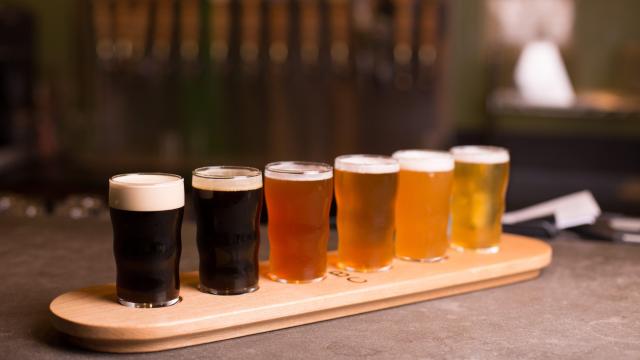I’ll never forget one of the first tables I served as an antsy new waitress, when a woman asked her husband, “What does ‘IPA’ even stand for?” The man replied, “It means it was made in America.” While his response was certainly patriotic, it was also objectively false.
I held my tongue at that table (Table 14, if you’re curious) for two reasons: First off, I still wanted a good tip. Secondly, even though I knew he was wrong, I didn’t actually know the correct answer myself. I’ve since grown my beer expertise, which is part of the reason why I was caught off-guard recently when faced with a seemingly basic question: What is the difference between a lager and an ale?
It turns out the difference between the two types of beer is pretty simple, yet hard to detect from clues like taste, aroma, or colour. Here’s what you need to know about difference between a lager and an ale, so that you can school any beer know-it-alls in your life — or at least get a better sense of what you like to order for yourself.
First off, there are only two types of beer
All beers fall under two main categories: ales or lagers. Some hybrid beers will blur the lines, but broadly speaking, any beer you order will be one of those two types. Complicating things is the fact that the distinction is not determined by flavour or alcohol content, but by the yeast used in brewing.
It all comes down to yeast
It’s that simple. Well, not that simple; evidently, the history of yeast is a long, storied one. For our purposes, though, all you need to know is that the yeast used in brewing determines whether a beer is classified as an ale or a lager.
Fun yeast facts (redundant): Ale yeast, Saccharomyces cerevisiae, is the same species of yeast we use to bake bread. Lager yeast, S. pastorianus, is allegedly named in honour of Louis Pasteur. Fun stuff.
Common misconceptions
In addition to yeast type, many online sources claim that ales are fermented with top-fermenting yeast at warm temperatures, and lagers are fermented with bottom-fermenting yeast at cold temperatures. These popular distinctions are not totally false, but not entirely accurate — at least not according to Craft Beer and Brewing Magazine. For instance, the top/bottom-fermenting yeast doesn’t account for the fact that “yeast activity is distributed throughout the liquid,” meaning that the yeast cells will all be at the top or the bottom of the beer at different points. Likewise, some lager yeasts perform well at relatively warm temperatures, and some ale yeasts at cooler ones.
The differences in fermentation patterns and temperatures between lagers and ales can get complicated, so you can play it safe by sticking to the one true distinction: yeast.
Examples of ales
While all beers start off as either ales or lagers, distinct styles and flavours spawn from there. Ales are traditionally linked with Belgium and Great Britain. Here are popular examples:
- Porters
- Stouts
- Wheat and Belgian styles
- India pale ales (IPA) (How I wish I could find that husband from Table 14 now…)
Examples of lagers
Lagers are associated with classic Bavarian and German beer history. Different styles include the following:
- Pilsners, imperial pilsners
- Bock
- Doppelbock
- Vienna style lagers
- American lagers: Miller High Life, Budweiser, and Coors
Perhaps not coming as too big a surprise, lagers are more palatable across the board and are the best-selling beer style in the world. Ales, on the other hand, have more extreme flavours, ranging from super hoppy to super malty.
Now that you’re equipped with the knowledge of lagers versus ales, go forth and educate all your friends. There’s nothing better than a night out at the pub with someone who can’t stop spewing beer facts, right?

Leave a Reply
You must be logged in to post a comment.